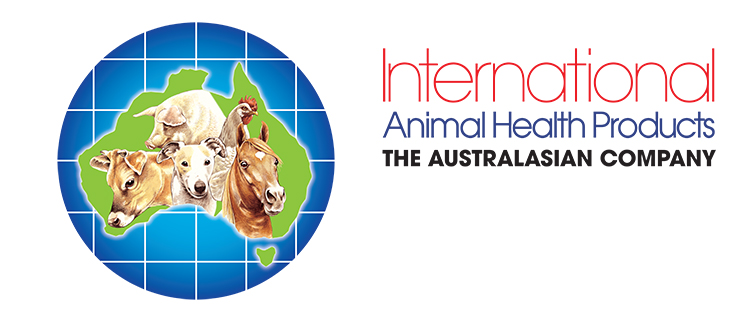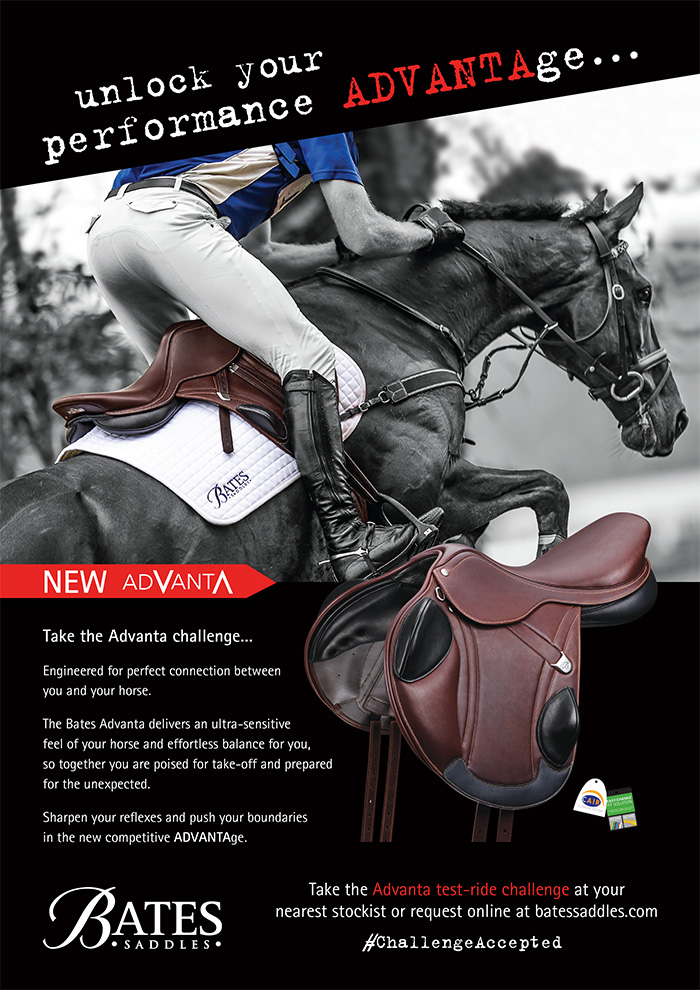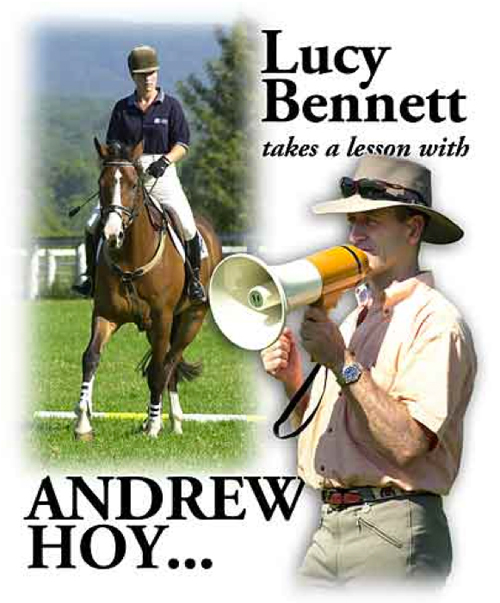 Words & Photos by Roz Neave
Words & Photos by Roz Neave
This article appeared in THM in 2002. Andrew Hoy has always been a gifted teacher with an emphasis on safety jumping. His message is simple, and important…
Our Lesson with Andrew Hoy and Lucy Bennett was conducted at the picturesque Hawkesbury Eventing Centre at the foot of the Blue Mountains. Although the session started before nine o’clock, it was one of those hot steamy New South Wales days, and already too hot for comfort. Triple gold medallist, Andrew started the session, which was the first of a three day clinic, in a very re-assuring manner.
“I want you to get as much out of this clinic as possible. If I say anything that you are not sure about, that is different to what you are used to being taught, something you are not sure about, don’t be afraid to say so. There’s nothing worse than walking out of a clinic wondering, what did he really mean by that?”
“I’m not a magician, I can’t just wave a wand and fix things. What I will do is act as a mirror, and tell you what I see. At the end of the day they are your problems and you are the only one who can fix your problems, and I’m the only one who can fix mine.”
“I feel that in many cases, riders get tied up with the technology of riding. They make it too complicated, and the more riding I have done, the more I go back to basics. Get the basics right, and you can then go on.”
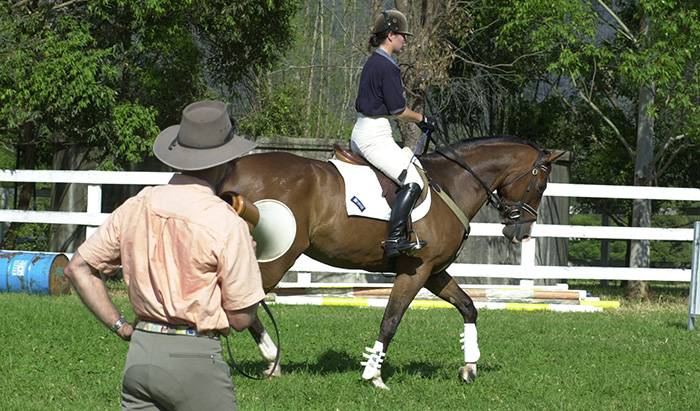
“Although it is hot, I am not going to be creating a hot and sweaty lesson. Many people judge a lesson on the basis of how high they jump, how wide they jump, and how many fences they jump. I’m not like that. What I can do is get you thinking about what you are doing, I’m not Mr Fixit, I just want you to go away thinking.”
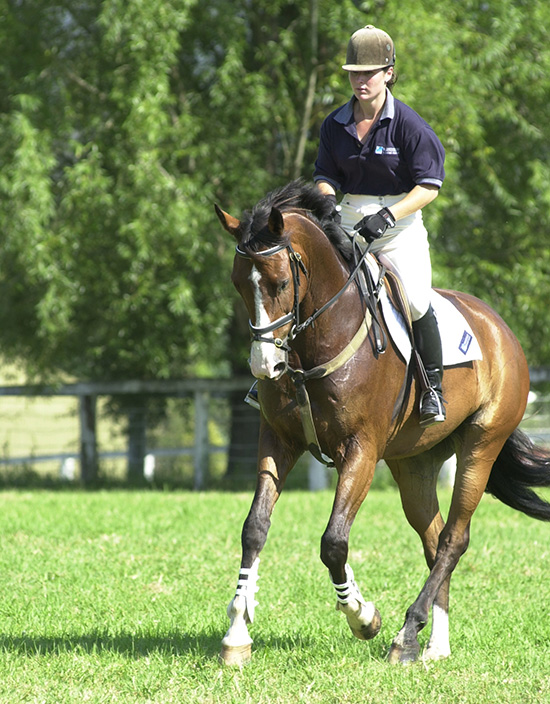
“In a lot of cases, we as riders do not have good body awareness. Instructors will say ‘raise your hands up and keep them still’ – we try to raise our hands and we think they are still, but they are not, because we are so tied up with other things in our minds. What I want you to be aware of, is what you are feeling and also what your body is doing.”
“You cannot get a quality jump with a bad approach – and the quality of your approach comes back to the way you work your horse on the flat. If you get a quality jump from a bad approach then you are a very lucky rider”.
“I try to keep what we teach the horse very simple. Four things – go forward, stop, turn right, turn left. Before we ever get on the horse, he can walk, trot, canter, gallop, do a flying change, jump a little log in the paddock. You hear someone say ‘I just taught the horse to do a flying change today’. They didn’t teach the horse to do a flying change, they taught the horse the aids for the flying change. We need to be very careful about how we assess what we’ve taught the horse.”
“Our communication tools are our eyes, our hands, our feet and our legs. This is where I feel riders get too tied up in the technology of riding. It really is pretty simple.”
“If you take your legs off and try to get the horse to go forward – nothing happens. If I take your reins away and say canter down that hill and stop twenty metres in front of the jump without any reins – you can’t do it. Legs make the horse go forward, seat to feel what is happening under you, hands to stop and turn right and turn left, eyes to view where you are going – and that is what we actually teach the horse: to go forward from the leg, to stop, to turn right, to turn left., and if you can do all those things when you want, and where you want, then we can produce a dressage test, or ride a cross country or showjumping course.
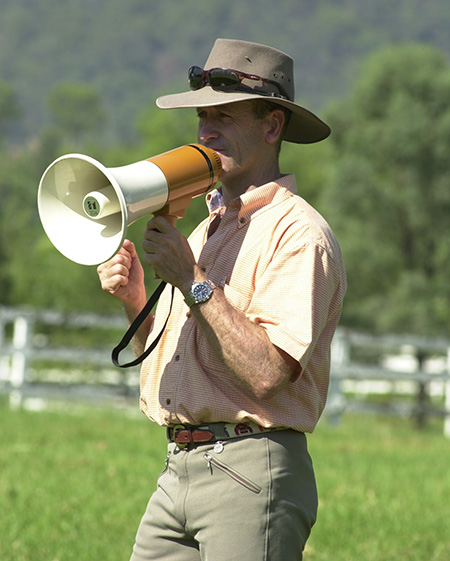
“Riders make it so complicated, and they end up with mental overload. If at any stage you have difficulties in your riding, if you take it back to that basic drill: Can I go forward? Can I stop? Can I turn right? Can I turn left? Is the horse responsive to my leg? Am I actually feeling what is happening underneath me through my seat and then responding correctly?”
“Teaching horses the skills of the half pass or the shoulder in, it’s all how they respond to our aids. Use the KISS method – keep it simple stupid.”
So it was off to warm up for Lucy, and Andrew kept a close eye on her as she trotted and cantered around the working area…
“Your basic skills are fine, don’t look so relieved… but there are a few position things that can be improved. Your rein is too long, and you are not riding with your fingers closed enough. I don’t want you to think I’m rude but you ride a little bit in the ‘armchair’ position”.
“When you are sitting on the horse do you feel that you are in a position of balance? Without moving your shoulders forward I want you to stand in the stirrups.”
“I feel like I’ll flip over backwards.”
“See, in the position you are sitting, you can’t do it”.
Andrew had made the point to Lucy that she needed to work on her position by getting her legs more under her. So now Lucy was warmed up and Andrew moved on to the bane of many eventers, the showjumping phase.
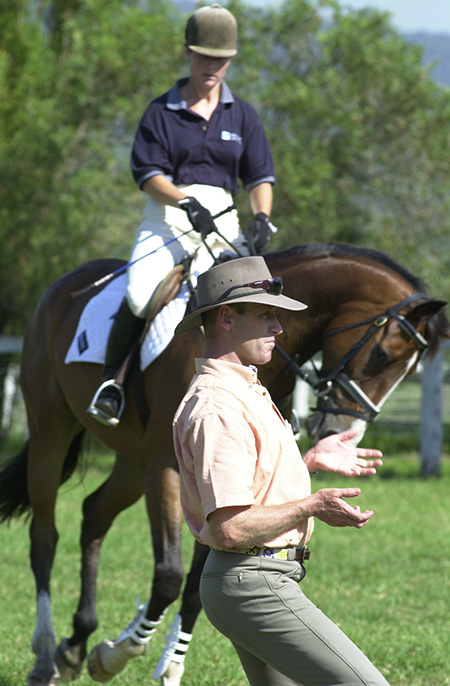
“What are you trying to achieve when you warm up for the showjumping?”
“I’m aiming to achieve a really connected canter…”
“Now with the event horse, that is a little bit different from the showjumper, because the showjumper canters very much with the power from behind. Because as eventers we do a lot of galloping with our horses, and travel faster with our horses than the showjumpers, we want a longer and more open canter stride – that’s why it is difficult for us when we come to the showjumping to get our horses to really jump. You can’t change your horse’s gait for each phase but I believe the better we have them schooled for the dressage, the easier it is to make the adjustment. That is why the work we do on the flat is the most important factor to our success when running across country and also in the showjumping”.
“I’d like you to go out, and get your horse a little rounder, keep your leg underneath you rather than out in front, so that the horse is responsive to your leg”.
“With your hands, bend him a little to the left and a little to the right, but I want to see his body straight along the line you are riding him, don’t let his hindquarters swing out. Also I want to see you ride with closed fingers. I often see riders, all over the world, with the fingers too open”.
And to correct the armchair seat …
“Use your legs to support yourself, put your legs back under you and get back into balance. Keep your reins shorter and your legs more back under yourself. You are riding your canter too much off the hand – when he is resisting you, that is because there is too much hand and not enough leg. What you need to do is not soften with the hand, but keep the leg there, and stay elastic through the elbows. As soon as you go shorter with your reins, because your hands are a little bit further in front, what you do is automatically pull back. Because you’ve got a comfort zone, near your body, and I’d like you to be able to alter that comfort zone so your hands are a little bit more in front of you, and bring your upper body forward a fraction, take your leg underneath you – rather than being behind the movement, I want you stay with the movement. It takes time to get an understanding for that change, because we all get comfort zones, and the older we get the more difficult it is to change”….said Andrew with a laugh!
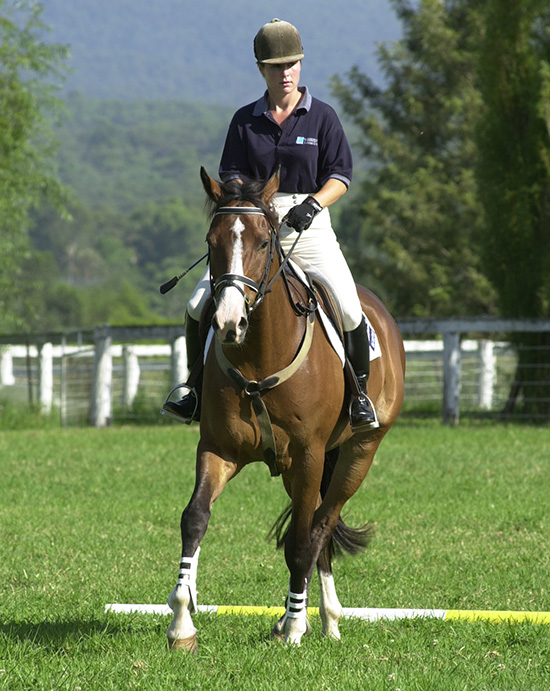
Now we come to the focus of this lesson, a single pole on the ground:
“I don’t doubt your ability to ride to a metre twenty fence and jump it, but what I want you to get out of our training sessions is the awareness of how you get to the jump. Is it sheer raw talent that gets you there, or guts and determination, or is it skill? This is where working over a pole on the ground can be so good because the horse will not make an adjustment itself coming to a pole on the ground, it is prepared to canter all over it and be all wrong. Coming to a metre twenty, the horse will make an adjustment. They’ll take off a little bit early, or a little bit close, they sight a fence and consciously make an effort to jump it, whereas cantering over a pole comes back to the rider’s skill, and you are looking at getting it right, ten out of ten times.”
Andrew is constantly working on increasing Lucy’s awareness of what is happening, and remember, we are only cantering over a pole on the ground.
“How was that?”
“Not enough leg.”
“The canter wasn’t round enough and submissive enough, is that what you mean when you say not enough leg?”
“Can I make him really really round?”
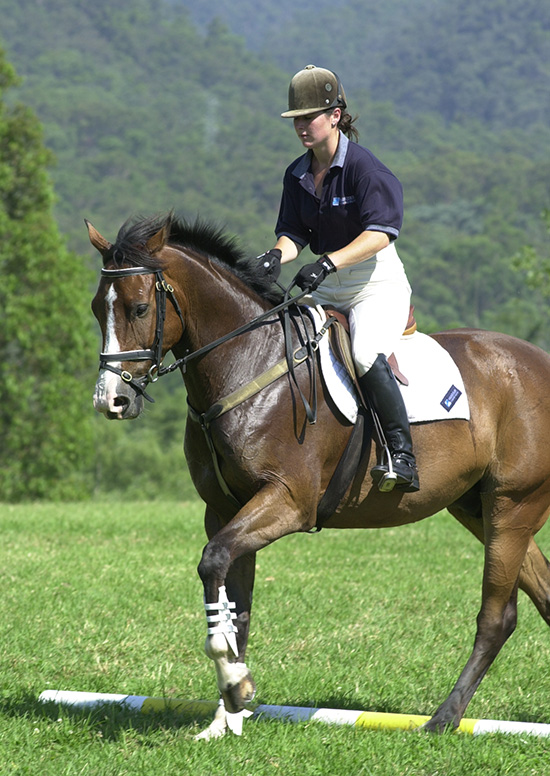
“For today’s exercise why don’t you do that, so that when you come to the pole he can’t come up, so you can maintain the rhythm. What is happening is that you are losing the rhythm as you come to the pole – he sights it, then he goes against you and you lose the roundness.”
“When he canters, every stride he takes you are leaving the saddle too much. You need to stay in the saddle so that you stay with the canter rhythm. If you are leaving the saddle, that means you are a little bit against the horse’s rhythm.”
Lucy started to slip back into her armchair position, so Andrew encouraged her to slightly round her lower back and absorb the movement better rather than sitting with a hollow back.
“How well, how economically you can get your horse around a track, depends on how well you can produce the canter on your approach.”
“It feels as if he comes behind the leg in the canter. I haven’t been riding him all that long, but he feels a little gobby, a little out of control sometimes…”
“That’s unacceptable. If he is out of control at Pre-Novice, he is not going to be under control at Novice, Intermediate or Advanced – that’s when the accidents happen. People ask why the accidents are happening, and the sad thing is that the one common factor is rider error. People look at the safety of the fences, but it does come back to rider education.”
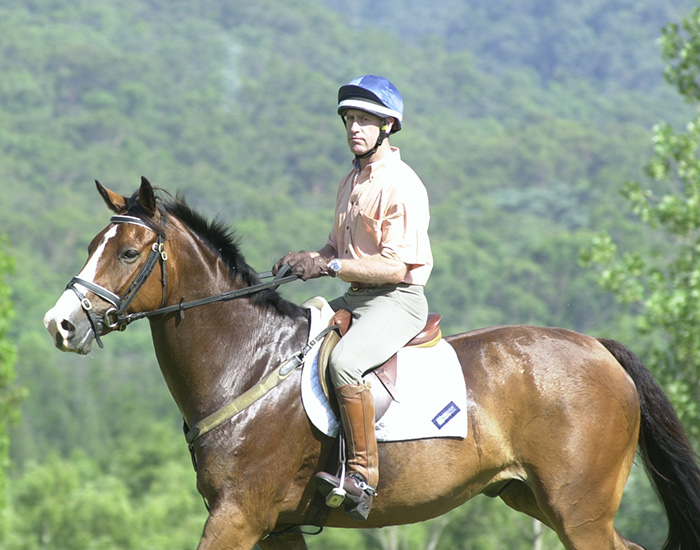
Andrew jumped on Lucy’s horse and asked him to come rounder.
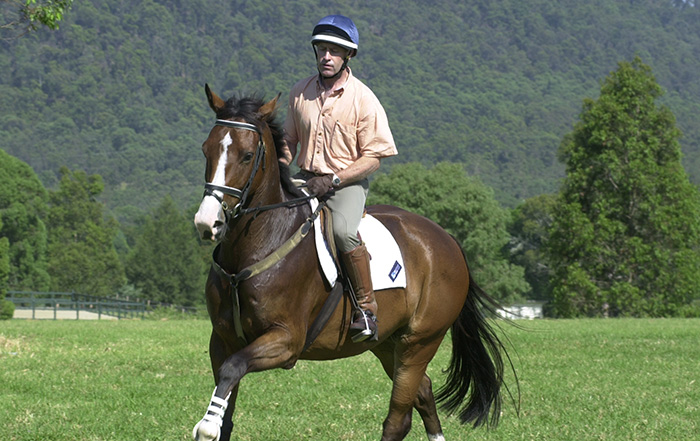
“He is not really responding to the leg. When I tried to use my legs more, I found him running out through the outside shoulder, he didn’t respond to the outside rein, so I had to use more outside leg, to say ‘come on, keep coming through from behind’, then he automatically went rounder. He wanted to come against me from the start, until I really sat firm, felt the rhythm and then he responded. If he went against my hand, I increased my leg. I did not just pull back. What I was concentrating on was the roundness and the control of the canter – then the rest will come.”
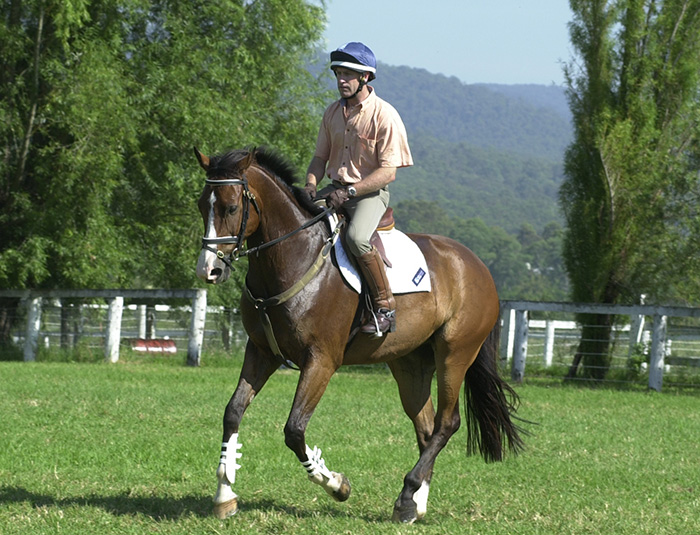
Andrew worked until he got the horse coming through from behind, Lucy re-mounted and tried to get the same feel.
“You’ve got to sit on the horse to feel what is happening under you – you won’t feel that if you leave the saddle. Use more outside leg, push his quarters to the inside, that’s better – be careful you are pushing yourself out of the saddle again. You are getting a rock through the shoulders as well, you need to keep your upper body quiet, keep very good posture on the horse, keep your lower leg under you so you almost feel that you are falling forward, that is the feeling you have to look for.”
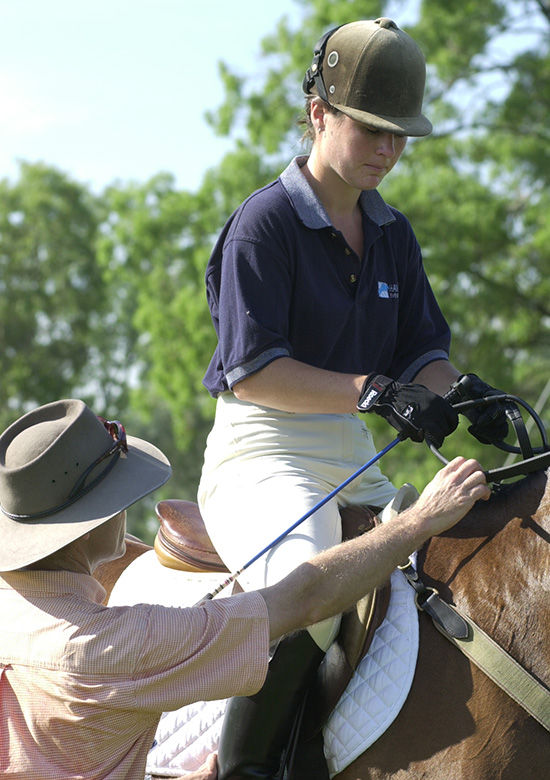
“When you are trying to change your position, you have to work really hard at it, because just when you think you are getting better, it is easy to slip back into old habits again. When you lift your hands up, it makes you tighter through your stomach muscles.”
“In a body awareness program, the muscles you have to tighten all come back to the pelvic floor area, and also the control of the abdominal muscles, it all relates to your posture. It is a matter of focussing on your body and being aware of it. This is often where riders go wrong. This is why I am not doing jumping with you now, because jumping is not your issue.”
“Once you are aware of your body, then you can correct your position the next time. Whenever my position has gone wrong for me, it has been through it not being a clear thought – not keeping the leg on, or not keeping the correct contact, allowing the reins to get too long, then you end up missing a fence. So many of these things come back to rider position, not jumping technique.”
“If you want to be able to train a horse to jump over something narrow, what is crucial is being able to ride the horse correctly to the fence – and if you get it right the first time rather than running past a few times and then finally getting it right, that is much better for the horse, we are not wearing the horse out. Horses have a limited number of jumps, and a limited number of miles in their lives.”
After around an hour and a half of intense concentration on the part of Lucy, her horse, Brilliant Venture and Andrew, the session finished. While Lucy took him back to the stables for a well-earned hose down, I asked Andrew what he thought Lucy had accomplished in the session.
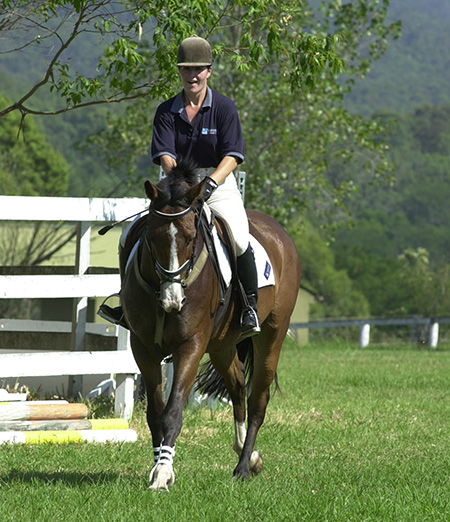
Andrew’s view:
“A lot of riders think that will make their jumping better by jumping as many jumps as possible. They will go and get a jumping lesson, as opposed to a dressage lesson or doing some physical exercises to teach them body awareness skills, and probably the last would help them most.”
“I have found that I am concentrating on body awareness more, because I’ve become aware that horses have a limited number of miles, of jumping efforts.”
“It takes much longer to get some horses going than others, some horses are naturally more talented than others, but is it partly due to the training skills of the rider. Klaus Balkenhol sits on my horses, they instantly go better – is this the horse, or is this the rider? It has got to be the rider…”
“If I get on Lucy’s horse, then there is a change, the horse hasn’t changed, but I’ve got to the tool to change the horse. This is a new aspect of my training philosophy. It is something that I think about a lot, about how our horses go and how we can produce the best performances with them – also watching what other trainers and riders can do with my horses.”
“It also comes from looking at the very good riders. Why can Mark Todd keep competing at a very high level, and doing so well at that level? Why is it that he could get on horses at the last minute and they would still go so well for him? It is the way horses are produced. Horses are made, they are not just bought.”


